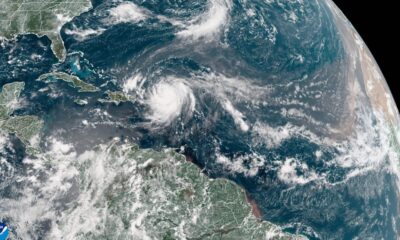Education
Hurricane Erin Strengthens, Impacts US East Coast and Bermuda

Hurricane Erin has intensified into a formidable Category 4 storm, posing significant risks to the US East Coast and Bermuda. The storm’s rapid development over the weekend has raised concerns about life-threatening surf and rip currents. While Erin is expected to remain offshore, its expansive wind field is already generating dangerous conditions along the coast, with large swells forecast to reach the eastern United States and Bermuda beginning Tuesday.
As noted by the National Hurricane Center, Erin’s outer rain bands have already impacted Puerto Rico, leading to flash flooding and power outages. The storm is currently affecting the southeast Bahamas and the Turks and Caicos Islands, with conditions likely to deteriorate further as Erin moves north. The National Weather Service in Morehead City, North Carolina, issued a beach hazards statement emphasizing the real danger posed by rip currents and high surf, despite Erin’s expected distance from land.
Forecast and Emergency Measures
Erin is predicted to curve north-northeast, maintaining its distance from the US coastline while potentially strengthening further. This trajectory means that the storm will influence coastal conditions through powerful surf and rip currents rather than a direct landfall. On Sunday, Dare County, North Carolina, which includes the Outer Banks, declared a local state of emergency, instituting a mandatory evacuation order for Hatteras Island.
According to a local news release, “Coastal flooding and ocean overwash are expected to begin as early as August 19, 2025, and continue through August 21, 2025.” Portions of North Carolina Highway 12 on Hatteras Island may be impassable for several days. Bermuda is also in Erin’s path, facing rough seas and potentially tropical storm-force winds later this week.
From South Carolina to the Delmarva Peninsula and the New Jersey shore, the risk of rip currents is set to increase sharply from Tuesday to Thursday, even under clear skies. So far this year, there have been 44 fatalities in the US due to rip currents and surf-zone hazards, as reported by the National Weather Service. Rip currents are recognized as one of the leading weather-related causes of death in the country.
Impact on Puerto Rico and the Bahamas
The outer bands of Erin are currently delivering heavy rainfall across Puerto Rico, with an additional 2 inches expected through Monday night. The National Weather Service has issued a flood watch for the island, where approximately 100,000 people experienced power outages due to the storm. The eastern Bahamas and the Turks and Caicos Islands may see rainfall accumulations of up to 6 inches through Tuesday, raising the risk of flash flooding and landslides.
Erin’s rapid intensification over the weekend has been notable, as it recorded one of the fastest bursts of strengthening in the Atlantic, escalating from tropical storm to Category 5 in just over a day. The storm peaked at winds near 165 mph before undergoing a structural change known as an eyewall replacement cycle. This process temporarily diminished wind speeds but ultimately allowed Erin to re-intensify to Category 4, broadening its wind field and extending the zone of hazardous surf and rip currents.
As the Atlantic hurricane season progresses, Erin marks the first hurricane of the year. While four other systems have formed, none reached the strength of a hurricane. Forecasters are closely monitoring a tropical wave trailing Erin, which has a medium chance of developing into a tropical depression or storm in the coming week.
While sea surface temperatures remain above average, they have not reached the record highs observed in previous years. The peak of the Atlantic hurricane season typically occurs from mid-August to mid-October, and meteorologists anticipate above-average tropical activity this year.
With summer crowds flocking to the coast, officials are urging beachgoers to heed warnings and avoid swimming during high surf conditions. Dare County Emergency Management stressed, “This is not the week to swim in the ocean. The risk from surf and flooding will be life-threatening.” As Hurricane Erin continues its path, vigilance and preparedness remain essential for those in affected areas.
-

 Technology4 weeks ago
Technology4 weeks agoDiscover the Top 10 Calorie Counting Apps of 2025
-

 Lifestyle1 month ago
Lifestyle1 month agoBelton Family Reunites After Daughter Survives Hill Country Floods
-

 Education1 month ago
Education1 month agoWinter Park School’s Grade Drops to C, Parents Express Concerns
-

 Technology2 weeks ago
Technology2 weeks agoDiscover How to Reverse Image Search Using ChatGPT Effortlessly
-

 Technology3 weeks ago
Technology3 weeks agoHarmonic Launches AI Chatbot App to Transform Mathematical Reasoning
-

 Technology1 month ago
Technology1 month agoMeta Initiates $60B AI Data Center Expansion, Starting in Ohio
-

 Lifestyle1 month ago
Lifestyle1 month agoNew Restaurants Transform Minneapolis Dining Scene with Music and Flavor
-

 Technology1 month ago
Technology1 month agoByteDance Ventures into Mixed Reality with New Headset Development
-

 Technology4 weeks ago
Technology4 weeks agoMathieu van der Poel Withdraws from Tour de France Due to Pneumonia
-

 Technology1 month ago
Technology1 month agoRecovering a Suspended TikTok Account: A Step-by-Step Guide
-

 Technology1 month ago
Technology1 month agoGlobal Market for Air Quality Technologies to Hit $419 Billion by 2033
-

 Health1 month ago
Health1 month agoSudden Vision Loss: Warning Signs of Stroke and Dietary Solutions

















